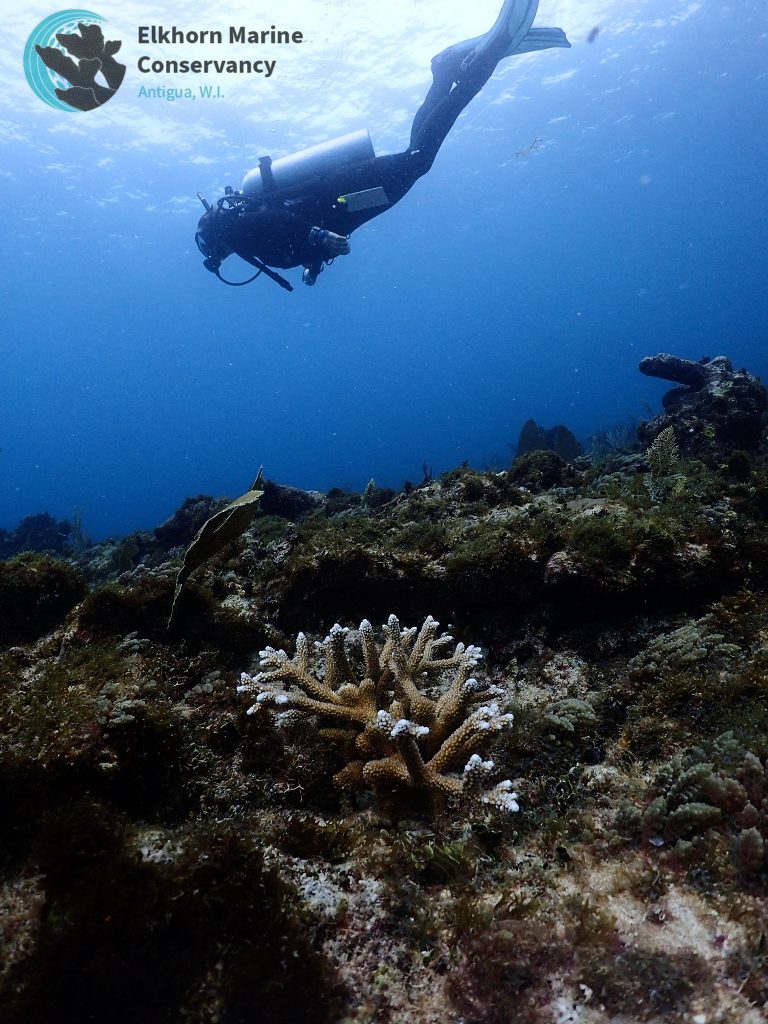

A “thicket” of elkhorn coral, spotted within the North East Marine Managed Area (NEMMA), gives a glimmer of hope that this species will once again dominate near-shore reefs in Antigua. Photos courtesy Elkhorn Marine Conservancy. 
A diver from the EMC’s science team searches for healthy corals on a reef near Green Island. Fragments of these healthy corals will be outplanted onto degraded reefs when ready.
By Orville Williams
In about two weeks, one of the largest coral restoration projects to be undertaken in Antigua and Barbuda will enter a decisive phase with the actual planting of live coral.
The project is being executed by the Elkhorn Marine Conservancy (EMC) nonprofit and will be focused on planting primarily elkhorn coral in the eastern area of the island – close to offshore islands, Green Island and York Island – where the coral there has been severely damaged over the years, due to a mixture of human impact, disease outbreaks and climate events.
Marine Scientist and consultant with EMC, Molly Wilson, told Observer that the project “will be pretty big”, adding that, “we’re hoping to have up to 2000 corals to outplant within the first year.”
The live coral will be planted – not onto artificial structures – but onto dead coral, which, in the case of the elkhorn, provides a similarly solid foundation.
Wilson explained that the area is currently a graveyard of dead coral, which is causing the reef to lose its function, meaning it won’t be capable of breaking as much wave activity to protect the coastline. It also means the reef – which is home to fish like grouper, grunt, parrotfish, snapper, as well as lobster and different types of urchins – won’t be able to hold as many of these species as it used to.
Encouragingly though, she also said there was evidence of some coral thriving in the same area, which means the project could achieve great success.
The main coral nursery will be based at York Island, while another – to be used mostly as a demonstration or a site to accommodate visitors – will be based at Ten Pound Bay on Green Island; the EMC is hopeful Green Island’s popularity will serve to boost awareness of the project, in turn helping to benefit the people that frequent the island.
Wilson says the project will also lean heavily on the local population for support.
“We’ll be trying to work with different community members, provide educational opportunities [and] work on looking at the opportunities to manage the area a bit better.
“Also, [we’ll be] getting a lot of input from the local fishermen in terms of how they use the area, how they want to be involved and how this project could potentially benefit the fisheries in the area as well.”
The need for coral restoration is not limited to the areas the EMC will be focusing on, as degradation caused by some of the aforementioned factors has affected coral in other parts of the island.
The EMC commended the work being done by National Parks in this regard, adding that they work closely to share methods and ultimately, coral fragments to determine how best to use the coral in different parts of the island.
The elkhorn coral – as Wilson explained – will be vital in this project, especially with the predictions for an active Atlantic Hurricane Season.
It has evolved to reproduce by being ‘broken up’ or displaced, meaning storm activity would not necessarily damage it, but instead help it to spread and grow further.
Along with the elkhorn coral, the planting phase of the project will also include the staghorn, the prolifera hybrid and to a more experimental extent, the finger coral and the boulder star coral.
Wilson said as another component of the project, they are hoping to experiment with using herbivores – including urchins and some species of Caribbean crab – to help clean the algae in the area they will be working.
The project is being funded by individual donors, but the EMC is hoping to also collaborate with the Ministry of Tourism, who they say have been very supportive.
“I think it has so many potential benefits for a really diverse group of people. It can help with [the country’s] tourism and its reputation of being proactive in the conservation and restoration world.
“Outside of that, you speak with so many people here who have incredible stories of what it used to look like and they want their kids and their grandkids to be able to see corals and these incredible reef ecosystems alive, that meant a lot to them growing up”, Wilson said.
Persons looking to find more information on this project could visit emcantigua.org.
